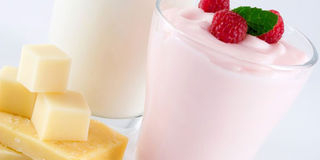Premium
Autism: Food is the key to controlling the symptoms

PHOTO | FILE Casein, found in dairy produce, aggravates autism.
What you need to know:
- My first suggestion was to eliminate sugar and refined foods. Very often, when I make this suggestion to parents, they tell me that they could not possibly deprive their child of sweets, cakes, chocolate, fizzy drinks, and juices. But you are not depriving them; you are giving them back their health
I know that when some people read this column, at the back of their mind they wonder, “How much difference can food make?”
Today’s story of a six-year-old autistic girl called Lydia shows that the answer is clearly “a lot”.
Lydia was diagnosed with autism at four years and her mother, Catherine, realising that what her daughter ate affected her health in a huge way, immediately put Lydia on a gluten- and casein-free diet, on the advice of a doctor.
Both gluten (found in wheat, oats, barley, and rye) and casein (found in dairy produce such as milk, cheese, and yoghurt) are types of protein that autistic children appear not to digest very well.
In their bodies, these partially digested proteins (called peptides) have a similar effect on the brain as opiate drugs like morphine. In fact, there is increasing scientific literature to suggest that behaviour associated with autism may be due to the brain chemistry getting a bit frazzled due to these “opioid-like peptides”. This is why exclusion diets are normally suggested.
Better health
And Lydia did improve. Over time, she made more eye contact and was more communicative, even though her speech was limited. Her grasp of the alphabet seemed to be better, too. However, despite these improvements, she was still pretty hyper and complained of tummy aches. She also would not go for a bowel movement on her own since she was scared of toilets and, even though her parents did not give her any fluid after 5pm, she would still wet her bed twice a week.
This is when Catherine brought Lydia to see me. Catherine knew that there was something else that was affecting Lydia, but she could not work out what it was.
My first suggestion was to eliminate sugar and refined foods. Very often, when I make this suggestion to parents, they tell me that they could not possibly deprive their child of sweets, cakes, chocolate, fizzy drinks, and juices. But you are not depriving them; you are giving them back their health.
Most children with autism and/or hyperactivity do not breakdown sugar as they should and, as a result, literally “go crazy” when they eat sweet things. I remember one child who practically kept jumping for the entire one-and-a-half-hour consultation.
The next thing I asked Catherine to do was to cut out foods that contained a substance called salicylate, which can have a similar effect in an autistic child’s body to gluten and casein.
Salicylates are found in apples, berries, cucumbers, grapes, nectarines, oranges, peaches, plums, prunes, raisins, tangerines, and tomatoes. Low-salicylate, low-sugar options include pears, grapefruits, lemons, limes, kiwis, coconuts, and papaya.
I also asked Catherine to give Lydia more soups (without the use of stock cubes, which can contain several nasties — see next week’s article), since they are a wonderful way of delivering pre-digested nutrients to the body, and an omega-3 supplement, which plays an important role in regularising brain function.
The difference after just four weeks was incredible. Not only had Lydia stopped wetting her bed, but she was calmer and had increased awareness of the things going on around her. Her teachers could not believe the difference — she was talking to other people and finally, they could start teaching her to read. Last of all, she could go to the bathroom on her own. Her parents could not have been happier.
The writer is a clinical nutritionist and certified by the Nutritional Therapy Council in the UK. Please direct any questions about family nutrition to her on [email protected]

